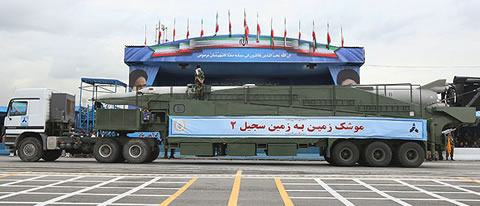
Above: the Iranians displayed the Ghadr-I Ballistic missile at the Army Day Parade 2010. This missile is capable of hitting targets at a range of 2000 km. The Iranians displayed an earlier version of the Ghadr in 2007. This missile is about four meter longer than the Shahab-3B/M versions, adding 35 seconds burn time. Photo: Ali Rafiei, Fars
Iran’s S-300 ‘look-alike’ – Hoax or Reality?
Iran has unveiled several new missiles and UAVs at the 2010 Army Day Parade, highlighting long-range ballistic missiles of the solid-propelled Safir and liquid propelled Shahab family. Iran also hints on the existence of a new missile in its arsenal, an S-300 ‘look-alike’. The vehicle displayed on the parade carries four cylindrical canisters measuring roughly as the S-300 container-launcher, but the Iranian vehicle does not show any erection apparatus. If these vehicles are part of a real system, they could be vehicles carrying reload missiles. The system is definitely not the Russian S-300, but could be a derivative of the Chinese HQ-9.

Yet, the likelihood of this vehicle being a true missile is questionable, according to Aviation Week reporter Dave Fulghum, that considers the Iranian display a hoax. Iran has claimed for several months now that it has developed an indigenous air-defense missile comparable to the S-300 it has ordered from Russia. Iran is also modernizing its Hawk missiles, into the locally modified Hawk (Shahin) to improve its air defense capability. Iran has also introduced the Mersad (Ambush) – a further improved version of the Hawk. Iran’s Defense Minister Ahmad Vahidi said recently that Iran’s defense industries began full scale production of the Mersad surface-to-air missile, considered to be superior to the missile Iran received from the USA during the 1970s. The range of the Mersad is claimed exceed 40 km. The system introduces modern radar signal processing technology, an advanced launcher, and improved guidance and target acquisition systems.

The parade included mostly locally developed and produced systems, and, therefore has not displayed the latest air defense system in Iran’s arsenal – the SA-15 Tor delivered by Russia few years ago. These point defense missiles being used to defend many of its nuclear sites.
The Iranians are also planning to introduce locally developed radars to replace a series of aging Russian-made systems currently deployed in the Persian Gulf. “The systems will be designed and installed chiefly for defense purposes,” said Vice President for Science and Technology, Nasrin Soltankhah. She added that the new radar systems will also feature capabilities to provide meteorological data for weather forecasting and analysis.
Iran’s Defense Minister Ahmad Vahidi said recently that Iran’s defense industries began full scale production of the Mersad surface-to-air missile, considered to be superior to the US-made Hawk missile Iran received from the USA during the 1970s. The Mersad introduces modern radar signal processing technology, an advanced launcher, and improved guidance and target acquisition systems.
The Iranians are also planning to introduce locally developed radars to replace a series of aging Russian-made systems currently deployed in the Persian Gulf. “The systems will be designed and installed chiefly for defense purposes,” said Vice President for Science and Technology, Nasrin Soltankhah. She added that the new radar systems will also feature capabilities to provide meteorological data for weather forecasting and analysis.

Anti-Ship Missiles on Display
Two classes of antiship missiles participated in the parade. The Ra’ad (Thunder), is the first indinenously produced anti-ship missile from Iran. Based on the Chinese HY-2 Silkworm, the Ra’ad and its Silkworm launcher were matched to a tracked platform to provide an all-terrain weapon system that can be deployed along the coastal plains of the Persian Gulf. The missile has a maximum range of 360 km. Iran is also producing three types of anti-ship missiles designed for operation from surface vessels or land vehicles.
These include the Chinese C-802, the land-based configuration carries three missiles, capable of attacking surface targets at distances of 120-180 km. The missile has an autonomous (self-targeting) range of 40 km. The Kosar is a smaller, short-range version of the Chinese C-701, This missile can be guided using radar or TV guidance.
The newly developed Nasr 1 is larger than the Kosar missile – based on the Chinese C-704 design. Longer and heavier than the C-701, the new missile has a heavier warhead, capable of destroying larger ships, with displacement of up to 3,000 tons. The Iranians designate the weapon a ‘cruise missile’, but it seems it is more likely a short-to-medium range anti-ship missile. According to Jane’s Air-Launched Weapons, the range of the C-704 is 170 km (106 miles) and its warhead weighs about 109 kg (240 pounds). There are probably two versions of the missile – one using radar guidance and another, operating a TV seeker. Future enhancement of the missile could also include air-launched versions. A longer range version of the Nasr could also be in development – most probably a long-range naval attack weapon based on the Chinese turbojet-powered C-705 cruise.
Iran is also fielding enhanced versions of the Noor (Chinese C-802), converted into an air-launched version that can be carried by Mi-17 helicopters and strike fighter jet aircraft.
Latest Ballistic Missiles on Parade
Among the ballistic missiles displayed on the parade were two Shahab 3 missiles and the solid-propelled Sejjil 2. All missiles were seemingly of operational capability, carried on erector-launchers, by commercial trucks.


Fateh 110 short range guided missile is believed to be based on the unguided Zelzal-1 rocket is probably the Iranian first attempt to develop an advanced ballistic missile having trajectory shaping, terminal maneuvering and precision attack capability. From the images have been released sofar it seems that the missile seems to be in development. Photo: Ali Rafiei, Fars



















